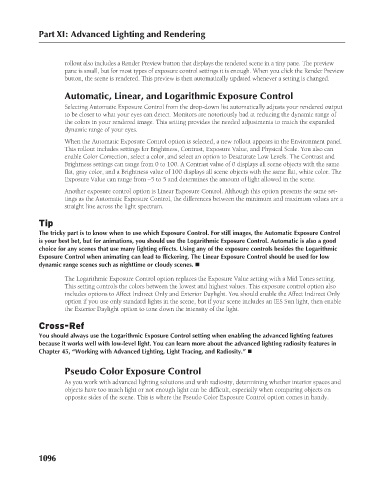Page 1144 - Kitab3DsMax
P. 1144
Part XI: Advanced Lighting and Rendering
rollout also includes a Render Preview button that displays the rendered scene in a tiny pane. The preview
pane is small, but for most types of exposure control settings it is enough. When you click the Render Preview
button, the scene is rendered. This preview is then automatically updated whenever a setting is changed.
Automatic, Linear, and Logarithmic Exposure Control
Selecting Automatic Exposure Control from the drop-down list automatically adjusts your rendered output
to be closer to what your eyes can detect. Monitors are notoriously bad at reducing the dynamic range of
the colors in your rendered image. This setting provides the needed adjustments to match the expanded
dynamic range of your eyes.
When the Automatic Exposure Control option is selected, a new rollout appears in the Environment panel.
This rollout includes settings for Brightness, Contrast, Exposure Value, and Physical Scale. You also can
enable Color Correction, select a color, and select an option to Desaturate Low Levels. The Contrast and
Brightness settings can range from 0 to 100. A Contrast value of 0 displays all scene objects with the same
flat, gray color, and a Brightness value of 100 displays all scene objects with the same flat, white color. The
Exposure Value can range from –5 to 5 and determines the amount of light allowed in the scene.
Another exposure control option is Linear Exposure Control. Although this option presents the same set-
tings as the Automatic Exposure Control, the differences between the minimum and maximum values are a
straight line across the light spectrum.
Tip
The tricky part is to know when to use which Exposure Control. For still images, the Automatic Exposure Control
is your best bet, but for animations, you should use the Logarithmic Exposure Control. Automatic is also a good
choice for any scenes that use many lighting effects. Using any of the exposure controls besides the Logarithmic
Exposure Control when animating can lead to flickering. The Linear Exposure Control should be used for low
dynamic range scenes such as nighttime or cloudy scenes. n
The Logarithmic Exposure Control option replaces the Exposure Value setting with a Mid Tones setting.
This setting controls the colors between the lowest and highest values. This exposure control option also
includes options to Affect Indirect Only and Exterior Daylight. You should enable the Affect Indirect Only
option if you use only standard lights in the scene, but if your scene includes an IES Sun light, then enable
the Exterior Daylight option to tone down the intensity of the light.
Cross-Ref
You should always use the Logarithmic Exposure Control setting when enabling the advanced lighting features
because it works well with low-level light. You can learn more about the advanced lighting radiosity features in
Chapter 45, “Working with Advanced Lighting, Light Tracing, and Radiosity.” n
Pseudo Color Exposure Control
As you work with advanced lighting solutions and with radiosity, determining whether interior spaces and
objects have too much light or not enough light can be difficult, especially when comparing objects on
opposite sides of the scene. This is where the Pseudo Color Exposure Control option comes in handy.
1096

